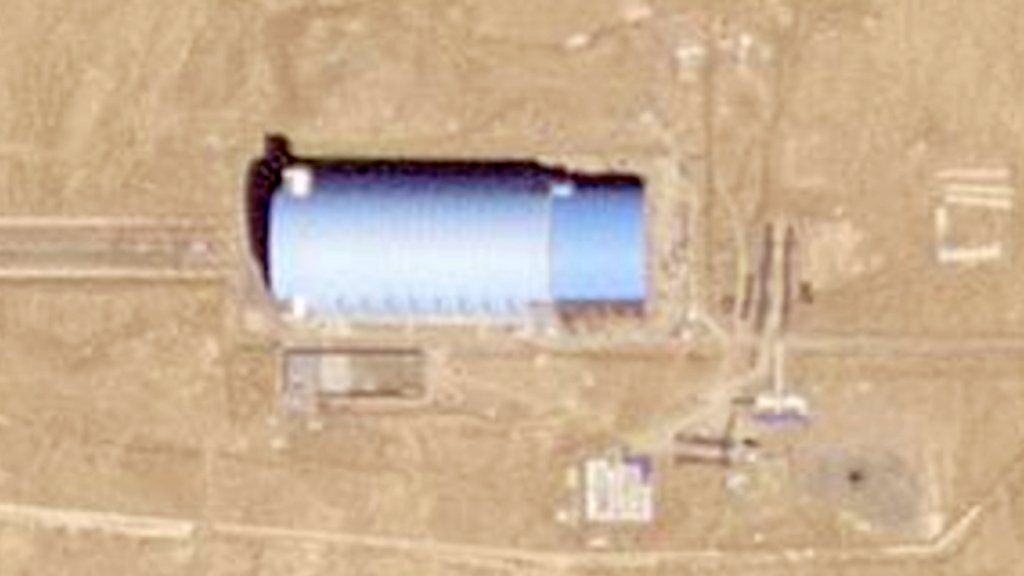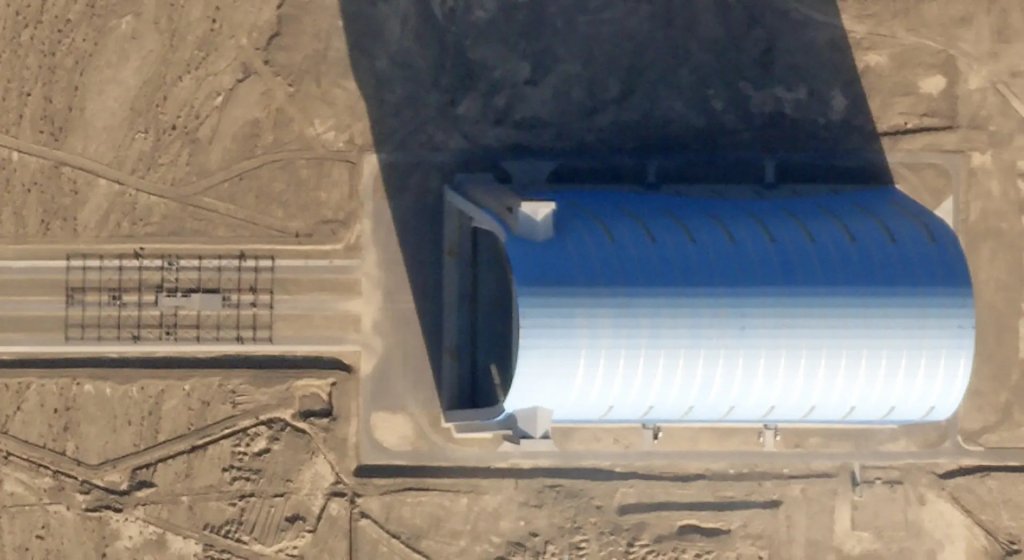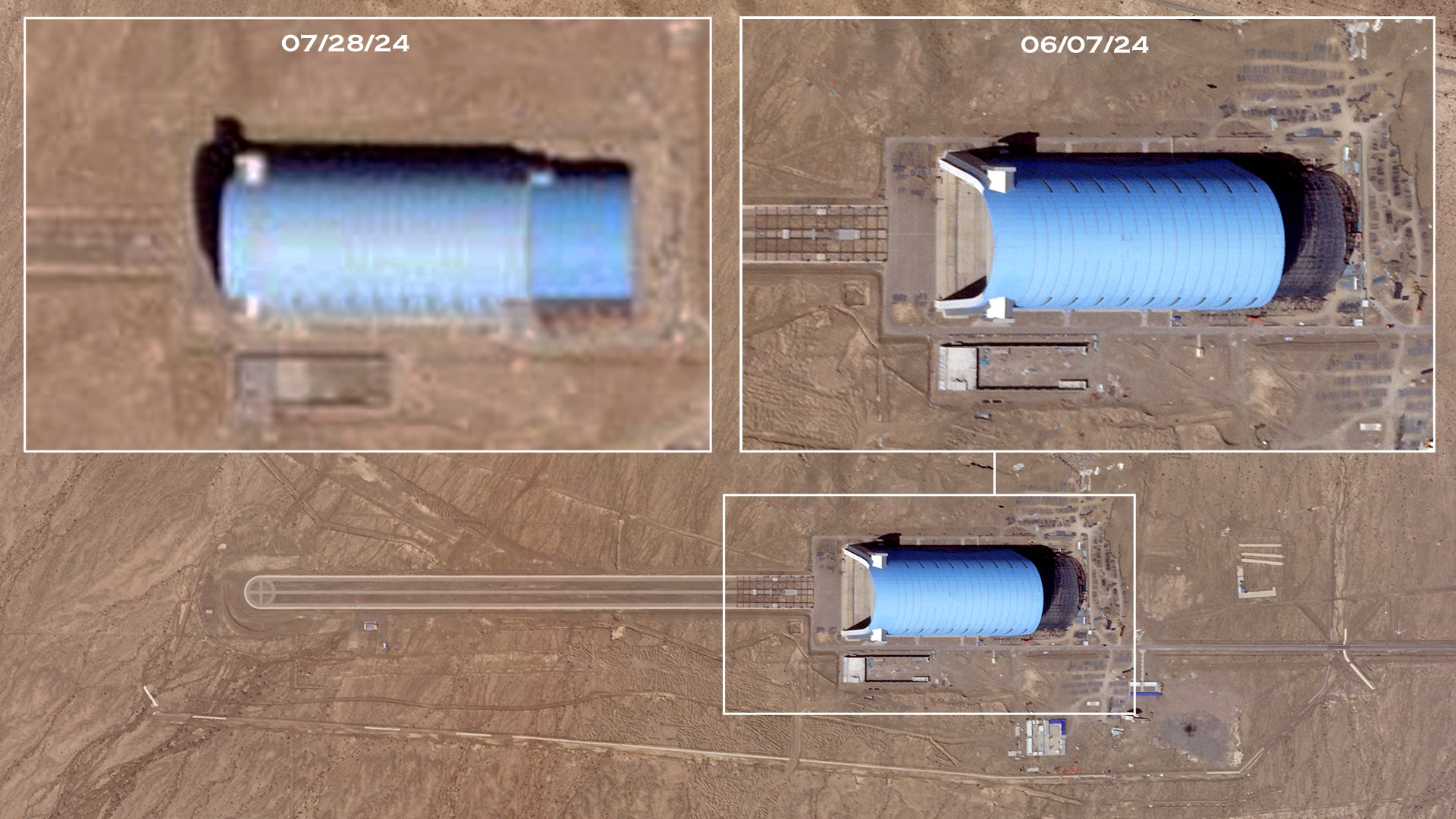An already absolutely massive hangar in a remote area of northwestern China is now even bigger after receiving a 300-foot-long addition. The War Zone has been following activities at the facility, which is tied to the country’s development of high-altitude airships that could potentially gather intelligence, facilitate long-range communications, provide early warning capabilities for missile defense, or even possibly serve as launch platforms for drones and other payloads.
But why would China need to make what is one of the largest, if not the largest, airship hangars on earth bigger than it already was? This development points to the possibility that China plans to develop larger airships, ones that could offer extreme performance and payload-carrying capabilities.
The addition to the hangar, which is situated near Bosten Lake in China’s Xinjiang Autonomous Region, can be seen in new satellite imagery that The War Zone obtained from Planet Labs. Construction of the original 1,150-foot-long and 450-foot-wide hangar, which is also extremely tall, started in 2013 and looks to have wrapped up in 2015. To give a sense of just how big the structure is, length and width-wise at least, a U.S. Navy Nimitz class supercarrier would have already fit inside the hangar with 100 feet to spare on either side before the extension was added on.

A review of additional Planet Labs imagery shows that work on the hangar extension was largely completed by July of this year.

In 2022, our Downlink team spotted work on the foundation for the addition to the hangar, as well as other construction pointing to a significant planned expansion of the overall site, as seen below.

A separate, smaller 450-foot-long rectangular foundation adjacent to the south side of the hangar that was visible in 2022 has since turned into a structure, that looks to be multi-storied, with an adjacent walled lot. Work on what is likely a group of administrative buildings immediately to the east appears to be complete, as well.
What prompted the new hangar extension is unknown. As already noted, the structure is tied to Chinese airship developments. Last year, separate satellite imagery from private firm BlackSky emerged showing what appeared to be a teardrop-shaped airship or aerostat on the operating area that extends from the hangar to the west.

The apparent lighter-than-air craft seen in the BlackSky image was substantially smaller than the hangar, as well as other known Chinese airship designs. The Yuan Meng and BNST-KT-02, reportedly around 246 and 328 feet long, respectively, are prime examples that you can learn more about here.

It is true that hangars of this size are often used to house multiple airships or other lighter-than-air craft at once. However, a larger rectangular cradle has been observed in front of the hangar Xinjiang in the past making clear that it is intended, at least in part, to house much bigger designs. A patent for a similar, if not identical cradle for moving airships around on the ground is also linked to an element of the People’s Liberation Army (PLA) known as Unit 63660, according to a report last year from CNN.

The new extension to what was already one of the largest hangars in the world only adds to the evidence that the facility is meant to shelter large airships, including ones of a sensitive nature, and points to the potential for even bigger designs to operate from there in the future.
The hangar and its associated facilities are located near other PLA sites tied to missile defense and anti-satellite activities, as well as work on electromagnetic pulse and directed energy weapons technologies. The entire area is sometimes referred to as Korla East, in reference to its proximity to Korla, Xinjiang’s second-largest city and the capital of the Bayingolin Mongol Autonomous Prefecture, as well as Bohu.
“Unit 63660 is not readily mentioned in Mandarin media until around 2019, around which time it has become clear that the unit is based out of Luoyang City, Henan Province, and maintains a testing facility in Xinjiang Province,” according to a 2023 paper from the U.S. Air Force’s China Aerospace Studies Institute (CASI). “Recent procurement announcements for the unit do indicate that some of the procured items would be used for satellite applications. The unit has rapidly received multiple HPM [high-power microwave] and EP [electromagnetic pulse] related invention patents since it appeared.”
Luoyang City is some 1,440 miles to the southwest from where the hangar is in Xinjiang.
“A 2023 recruitment notice for Unit 63660 stated it originated in the time of the ‘Two Bombs one Satellite Era‘ and embodies the ‘Malan Spirit,’ indicating its historical connection with former GAD [PLA General Armaments Department] Base 21 in Xinjiang Province, the unit number for which was Unit 63650,” the 2023 CASI paper adds. “The recruitment notice also states that the unit is involved in leading edge weapons testing and evaluation in the fields of electronics and information technology, military weapons development, aerospace technology, and artificial intelligence unmanned systems.”

Base 21, which subsequently fell under the PLA’s Strategic Support Force (PLASSF), is a highly classified nuclear test complex headquartered in Malan on the opposite side of Bosten Lake from where the hangar is located. The PLA announced plans earlier this year to dissolve the PLASSF and replace it with three separate entities, the Aerospace Force, the Cyberspace Force, and the Information Support Force.
The PLA Air Force’s (PLAAF) secretive Malan Air Base, a major test and evaluation hub, is also situated near the northern side of the lake.
All of this is in line with The War Zone‘s previous assessments that the hangar and related airship developments could very well be intertwined, at least to a degree, with missile defense, anti-satellite, and other advanced Chinese military research and development efforts. At the same time, the PLA has a clear interest in airships and other lighter-than-air craft for use in a variety of more conventional roles, as well, including as launch platforms for munitions and swarms of uncrewed aerial systems. Carrying outsized cargo remains a very viable role for large airships, too. This reflects something of a growing trend now among armed forces around the world, including the U.S. military, but China is a definite leader in this space.
The kinds of craft that would fill up event part of the newly extended hangar in northwestern China could be equally huge with extreme range and endurance capabilities. Large, high-flying, and long-endurance lighter-than-air craft offer platforms with uniquely vast fields of view for sensors and communications systems that can operate across long distances and/or for extended periods in a designated area. Especially using solar power, uncrewed airships and balloons could potentially operate for months or even years at a time without needing to land, acting as pseudo-satellites supporting intelligence, surveillance, and reconnaissance (ISR), communications relay, and other missions.
The Chinese government has already been investing heavily in stratospheric intelligence-gathering capabilities utilizing powered and/or steerable high-altitude balloons and other lighter-than-air craft capable of regional and intercontinental operations. This became an international cause célèbre after a Chinese spy balloon intruded into U.S airspace last year and was subsequently shot down after passing over parts of the United States and Canada. The incident drew attention to prior sightings of similar balloons in the Pacific region. A more airship-like design with some broad similarities to the Yuan Meng was spotted over the South China Sea close to the island of Luzon in the Philippines in 2022, as well. Control of various shoals in the waters to the west of Luzon is particularly hotly contested between China and the Philippines.
Earlier this year, authorities in Taiwan also accused their counterparts on the mainland of engaging in a campaign of psychological warfare, as well as threatening the safety of civilian air traffic in the region, with a spate of high-altitude balloon launches over the island. As another example of the use of lighter-than-air craft for general harassment outside of the context of an open conflict, North Korea sent hordes of balloons carrying excrement and other trash over South Korea earlier this year. Those incidents, which disrupted civilian air traffic and raised concerns about what else might be in the balloons’ payloads, underscored the very real potential threats that light-than-air craft can pose.
When it comes to the enlargement of the hangar in the desert in Xinjiang, this only underscores China’s lighter-than-air ambitions and points to the potential for still larger and more capable airship designs on the horizon.
Contact the author: joe@twz.com
